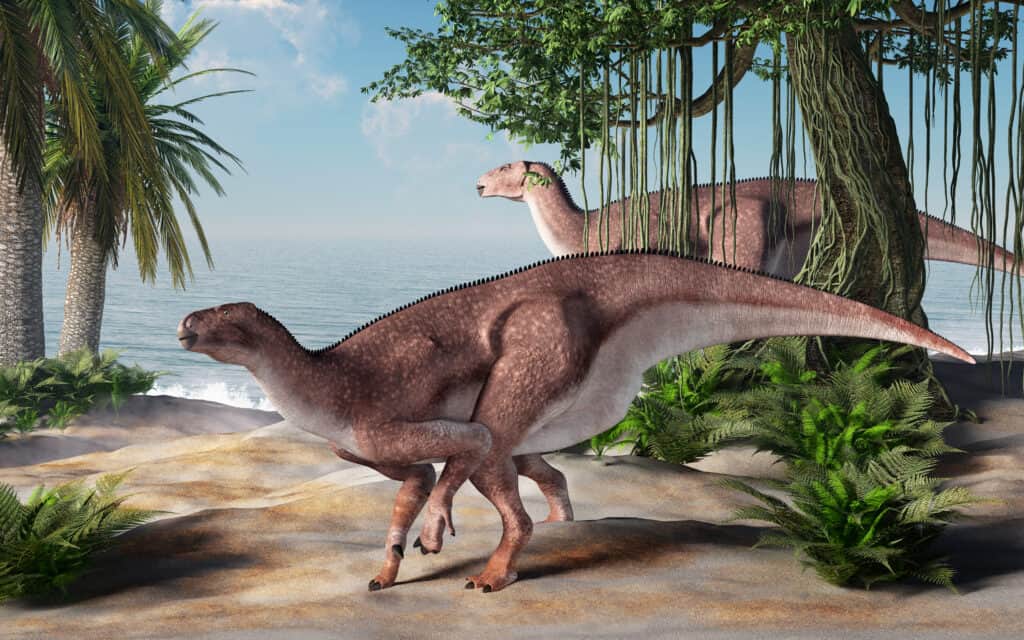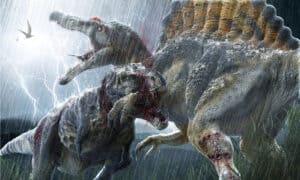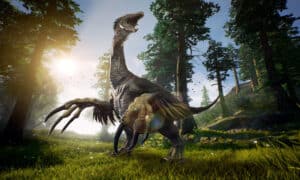Iguanodons were large, plant-eating dinosaurs. They could walk on all fours, as well as their two back feet. Their rear legs were powerful and muscular but likely didn’t allow for much running. Their front arms, which were sometimes used as feet, had mostly stiff digits that could support their weight. However, their fifth finger could have helped them to manipulate objects. They had beaks and a mouth full of large, closely packed iguana-like teeth.
The Long Road to The Name Iguanodon
The Iguanodon is an important dinosaur for paleontological discoveries. It is only the second dinosaur ever to be named, way back in 1825. In 1820, Gideon Mantell, an obstetrician, and paleontologist discovered some bones and carnivorous teeth that he attributed to a giant crocodile in Sussex, England. Some strange teeth belonging to an herbivore were discovered in the same area in 1822. Mantell began to put two and two together – there may have been a giant carnivorous lizard in addition to an herbivorous one!
Mantell presented his herbivorous findings to The Royal Society of London as well as notable scientists of the era, but they were dismissed as fish teeth or perhaps teeth from a prehistoric rhino. It wasn’t until 1824 that French naturalist George Cuvier, who had previously been in the rhino camp, finally agreed that they may be the teeth of a giant, herbivorous lizard. It was then that Mantell felt confident to give his findings a name.
After musing on choices, including Ignuanosaurus, He settled on Iguanodon, meaning “iguana toothed” because the teeth of the reptile were similar to those of an iguana. The findings and official name were first presented to the Royal Society of London in 1825.
How Big Were Iguanodons?
Early estimates from the 1800s put Iguanodons at nearly 60 feet long. However, using modern techniques researchers have determined that the average Iguanodon was probably more like 26 feet long. They weighed around 3.5 tons.

The well-known dinosaur, the Iguanodon, lived in what is now Europe around 125 million years ago.
©Daniel Eskridge/Shutterstock.com
A Dinosaur with a Thumb?
Iguanodons had a sharp, thumb-like appendage. Researchers are not entirely sure what it was used for, but they believe it could have been a tool for self-defense. It may have also been used to break open fruits or nuts.
Did Iguanodons Live in Herds?
It’s not clear whether or not Iguanodons lived in herds. While there have been massive fossil sites, where it seems multiple Iguanodons died all together at the same time. In some of them, there was no young Iguanodons present, which indicates a lack of herding behavior. Some scientists believe that Iguanodons may have died from time to time in a river, and the remains all got washed away to the same location due to the flow of the river. However, a wide variety of Iguanodon ages were present at another site, so researchers just are not sure. They need more evidence to determine if Iguanodons lived in herds.
When Did Iguanodons Live?
Iguanodons were around between 113 and 126 million years ago, spanning both the late Jurassic and early Cretaceous periods.
Important Iguanodon Finds
Since the Iguanodon is one of the first recognized dinosaurs, there have been many important fossil findings over the past 200 years.
The Bernissart Mines
Starting in 1878, researchers found 38 Iguanodon skeletons, some of them quite complete, and the Benissart Mines in Belgium. One Iguanodon subspecies was named after the location, Iguanodon bernissartis. The findings at these mines were some of the first nearly complete dinosaur skeletons ever found, making them important for dinosaur research in general. The subspecies found at this mine was the first dinosaur to ever be mounted and displayed. It is still on display that the Royal Museum of Natural History in the U.K.
German Iguanodon Findings
In the 1970s and 1980s, 15 Iguanodon skeletons were found in a quarry near the small town of Nehden, Germany. At this location, the smallest, and therefore possibly the youngest, Iguanodon skeletons were found, adding more specimens for researchers to study. The findings here support the idea that Iguanodons may have lived in herds due to the variety of ages present.

Bernissart’s Iguanodon is in the quadrupedal position at the Royal Belgian Institute of Natural Sciences.
©By Ben2 – Own work, CC BY-SA 3.0, https://commons.wikimedia.org/w/index.php?curid=3166764 – License
Misclassified Iguanodons
Because this dinosaur was one of the first to be studied and named, there are many other early dinosaur findings that were attributed to the Iguanodon species. At the time, scientists simply didn’t know just how many dinosaur species there would turn out to be! Some of the findings attributed as Iguanodons from the 1800s turned out not to be dinosaurs at all, while others were later renamed and reclassified as other species.
The Iguanodon in Popular Culture
As one of the first dinos to ever be given a name, the Iguanodon is firmly implanted into pop culture. It has been featured in many dinosaur movies, both fiction and non-fiction. Iguanodons are the main characters in the 2000 Disney movie Dinosaurs and appear in the classic The Land Before Time. The documentaries Dinosaur Britain and Walking with Dinosaurs also feature the Iguanodon.
It’s not only movies that get the Iguanodon honor. The famous Sir Arthur Conan Doyle book, The Lost World, features Iguanodons, as does Raptor Redd, a 1995 book by Bob Bakker.
The photo featured at the top of this post is © rodos studio FERHAT CINAR/Shutterstock.com
Sources
- Wikipedia, Available here: https://en.wikipedia.org/wiki/Iguanodon
- Natural History Museum, Available here: https://www.nhm.ac.uk/discover/dino-directory/iguanodon.html
- Natural History Museum, Available here: https://www.nhm.ac.uk/discover/the-discovery-of-iguanodon.html
- Natural Library of Medicine, Available here: https://pubmed.ncbi.nlm.nih.gov/2884670/
- Second, Available here: https://second.wiki/wiki/nehden
- Facts Just For Kids, Available here: https://www.factsjustforkids.com/dinosaur-facts/iguanodon-facts-for-kids/
FAQs (Frequently Asked Questions)
What is it called an iguanodon?
Iguanodon means “iguana toothed.” The teeth of the iguanodon are similar to those of an iguana.
How big were Iguanodons?
Iguanodon was 26 feet long on average. They weighed around 3.5 tons.
Did Iguanodons live in herds?
It’s unknown whether or not iguanodons lived in herds. While there have been massive fossil sites, where it seems multiple iguanodons died all together at the same time, in some of them, there were no young iguanodons present, which indicates a lack of herding behavior.
When did Iguanodons live?
Iguanodons were around between 113 and 126 million years ago, spanning both the late Jurassic and early Cretaceous periods.
Who discovered the iguanodon?
Gideon Mantell, an obstetrician, and paleontologist discovered the first Iguanodon remains.
Who named the Iguanodon?
Gideon Mantell, an obstetrician, and paleontologist, gave the Iguanodon its name.
Why is the Iguanodon important?
The Iguanodon is important because it was only the second dinosaur to be named and its bones were among the first dinosaur remains found and recognized as an herbivorous dinosaur.
Thank you for reading! Have some feedback for us? Contact the AZ Animals editorial team.






